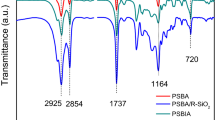Abstract
Oil-absorbing resins containing cross-linked poly(butyl acrylate) (PBA) were synthesized via precipitation polymerization in an environment-friendly route using supercritical carbon dioxide as the reaction media. The PBA resins were then regenerated through subcritical CO2 extraction process. The PBA resins with macroporous structures, prepared at pressures ranging from 17.5 to 24.5 MPa, were characterized by field emission scanning electron microscopy and mercury porosimetry. These structures are beneficial to oil absorption. Thermogravimetric analysis results showed that the PBA resin has good thermal stability. The effect of reaction pressure, initiator ratio, cross-linker content, and absorption time on yield and oil absorption was also investigated. The results revealed a slight decrease in yield with increasing pressure, within a pressure range of 17.5–24.5 MPa. The high initiator concentrations did lead to the decrease in the oil absorption capacity of the PBA resin. A higher product yield of 55% is acquired in the presence of the higher cross-linker content of 20 wt%. The highest absorption capacity of diesel oil onto the PBA resin was 7.5 g/g with oil retention capacity of 95.2%. Moreover, oil desorption of oil-saturated PBA resin was conducted with carbon dioxide instead of the traditional extraction solvents. After 10 repetitions, PBA resin exhibited good recyclability.











Similar content being viewed by others
Explore related subjects
Discover the latest articles, news and stories from top researchers in related subjects.References
Peterson CH, Rice SD, Short JW, Esler D, Bodkin JL, Ballachey BE, Irons DB (2003) Long-term ecosystem response to the Exxon Valdez oil spill. Science 302:2082–2086
Chen Q, Bao M, Fan X, Liang S, Sun P (2013) Rhamnolipids enhance marine oil spill bioremediation in laboratory system. Mar Pollut Bull 71:269–275
Aurell J, Gullett BK (2010) Aerostat sampling of PCDD/PCDF emissions from the Gulf oil spill in situ burns. Environ Sci Technol 44:9431–9437
Rajakovic V, Aleksic G, Radetic M, Rajakovic L (2007) Efficiency of oil removal from real wastewater with different sorbent materials. J Hazard Mater 143:494–499
Ge M, Cao C, Huang J (2018) Rational design of materials interface at nanoscale towards intelligent oil–water separation. Nanoscale 3:235–260
Su C (2009) Highly hydrophobic and oleophilic foam for selective absorption. Appl Surf Sci 256:1413–1418
Zhou X-M, Chuai C-Z (2010) Synthesis and characterization of a novel high-oil-absorbing resin. J Appl Polym Sci 115:33211–33325
Sun J, Xu Y, Chen H, Tan Z, Fan L (2014) Synthesis and properties of high oil-absorbing resins with long chain by high internal phase emulsions as template. Sep Sci Technol 49:2518–2524
Hori K, Sano M, Suzuki M, Hanabusa K (2018) Preparation of porous polymer materials using water-in-oil gel emulsions as templates. Polym Int 67:909–916
Kiran E (2016) Supercritical fluids and polymers—the year in review-2014. J Supercrit Fluid 110:126–153
Kendall JL, Canelas DA, Young JL, DeSimone JM (1999) Polymerizations in supercritical carbon dioxide. Chem Rev 99:543–564
Cao L, Chen L, Lai W (2007) Precipitation copolymerization of N-isopropylacrylamide and acrylic acid in supercritical carbon dioxide. J Polym Sci Part A Polym Chem 45:955–962
Ramírez-Wong DG, Posada-Velez CA, Saldívar-Guerra E, Luna-Bárcenas JG, Ott C, Schubert US (2009) Silicon-based and fluorinated polymeric surfactants for nitroxide mediated dispersion polymerization in supercritical carbon dioxide. Macromol Symp 283–284:120–129
O’Connor P, Zetterlund P, Aldabbagh F (2010) Effect of monomer loading and pressure on particle formation in nitroxide-mediated precipitation polymerization in supercritical carbon dioxide. Macromolecules 43:914–919
Dong XJ, Li X, Xie ZP, Weng S, Zhang WY, Ying XG (2018) Preparation of silica/poly(styrene-co-butyl acrylate) core/shell composite particles for absorption of toluene. J Appl Polym Sci 135(16):46172
Wong TW, Wu JJ, Yang M, Kadir MRA, Wahit MU, Zhao Q (2017) Multifunctional shape-memory foams with highly tunable properties via organo-phase cryo-polymerization. J Mater Chem A 5:9793–9800
Cui XL, Shao H, Song YR, Yang S, Wang F, Liu H (2019) Preparation of highly interconnected porous polymer microbeads via suspension polymerization of high internal phase emulsions for fast removal of oil spillage from aqueous environments. RSC Adv 9:25730–25738
Zhang T, Gu QP (2017) Continuous preparation of polyHIPE monoliths from ionomer-stabilized high internal phase emulsions (HIPEs) for efficient recovery of spilled oils Chem. Eng J 307:812–819
Ji N, Chen H, Yu M, Qu R, Wang C (2011) Synthesis of high oil-absorption resins of poly (methyl methacrylate-butyl methacrylate) by suspended emulsion polymerization. Polym Adv Technol 2011(22):1898–1904
Wu S, Straub M, Gu M (2005) Single-monomer acrylate-based resin for three-dimensional photonic crystal fabrication. Polymer 46:10246–10255
Ma C, Cao L, Wang X, Zhang L, Shi M, Wang J (2012) Characterization and adsorption capacity of a novel high-performance polymeric sorbent synthesized in supercritical carbon dioxide. J Supercrit Fluids 62:232–239
Park Sk, Lee ES, Sulaiman WRW (2015) Adsorption behaviors of surfactants for chemical flooding in enhanced oil recovery. J Ind Eng Chem 21:1239–1245
Duan Y, Bian F, Huang H (2016) Facile fabrication of porous oil-absorbent microspheres with high oil absorbency and fast oil absorption speed. Polym Adv Technol 27:228–234
Acknowledgements
The authors acknowledge the research grant provided by National Natural Science Foundation of China (Nos. 51763020; 51963019).
Author information
Authors and Affiliations
Corresponding author
Additional information
Publisher's Note
Springer Nature remains neutral with regard to jurisdictional claims in published maps and institutional affiliations.
Rights and permissions
About this article
Cite this article
Wu, X., Li, J., Wang, J. et al. Poly(butyl acrylate) gel prepared in supercritical CO2: an efficient recyclable oil-absorbent. Int J Ind Chem 11, 91–99 (2020). https://doi.org/10.1007/s40090-020-00204-2
Received:
Accepted:
Published:
Issue Date:
DOI: https://doi.org/10.1007/s40090-020-00204-2




